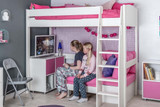What's the Reason Behind the Traditional Gender Colours for Kids?
To discover the reason behind the traditional gender colours for kids, one must explore when pink first became a colour designating girls, and blue was the preferred colour for boys. A look at the history of children’s clothing provides some interesting insight.
In the 1800s, infant boys and girls both wore white dresses. It was not until studies into infant development disclosed the importance of crawling that children’s clothes began to provide freedom of movement.
According to the Smithsonian, “The march toward gender-specific clothes was neither linear nor rapid. Pink and blue arrived, along with other pastels, as colours for babies in the mid-19th century, yet the two colours were not promoted as gender signifiers until just before World War I—and even then, it took time for popular culture to sort things out.”
The following timeline provides some clues to the development of gender-specific clothing colours:
- Early 1900s – Gender specifications for kids colours was not the norm.
- 1905 – A Times article said pink was for girls and blue for boys.
- 1918 – The June 1918 issue of the Infant's Department, a trade magazine for baby clothes manufacturers, said, “There has been a great diversity of opinion on this subject, but the generally accepted rule is pink for the boy and blue for the girl. The reason is that pink being a more decided and stronger colour, is more suitable for the boy; while blue, which is more delicate and dainty is prettier for the girl."
- 1927 – A 1927 chart in Time Magazine showed that when department stores in various cities were contacted and asked what colours they used for boys and girls, their responses were varied.
- 1945 - After the Second World War, the modern convention of pink for girls and blue for boys started to dominate. Some clothing historians have related this to the blue of many military uniforms.
- 1939 – Parents magazine said pink was for girls and blue for boys.
- 1940s – Manufacturers settled on pink for girls and blue for boys.
- 1960s and 1970s – Unisex baby clothes came into style as a result of the women's liberation movement.
- 1980s – Pink and blue came back into popularity with the advent of prenatal testing and the ability to know prior to birth if a baby was male or female.
- 2007 – A 2007 study found evidence that males and females may be sensitive to different regions of the colour spectrum.
Ultimately, there is not one simple, definitive answer to the gender colour question. Factors which may have influenced gender colours for kids include, but are not limited to, the following:
- When mass marketing appeared, gender colours were cleverly used to convince buyers they needed to buy certain products for their new babies.
- The French set the fashion in the 20th century and French culture paired blue with boys and pink with girls.
- Some credit biological colour preferences as research showed female monkeys preferred warm colours like pink and red.
Although we may never know the true origin of pink for girls and blue for boys, it appears to come from both cultural and biological factors. Today, parents have many options from which to choose when picking colours for their kids. If you truly enjoy the traditional pinks and blues, go for it! However, if you enjoy expressing your individuality and that of your kids, pick any colour you both love.
Recent Posts
-
Unlocking the Potential of High Sleeper Beds for Teenagers
As teenagers go through all the ups and downs of being a teen, their likes and dislikes change a lot
-
Choosing Between a High Sleeper Bed vs. Mid Sleeper Bed
As your little one grows, so do their needs, and finding the perfect kids’ bed for them becomes









